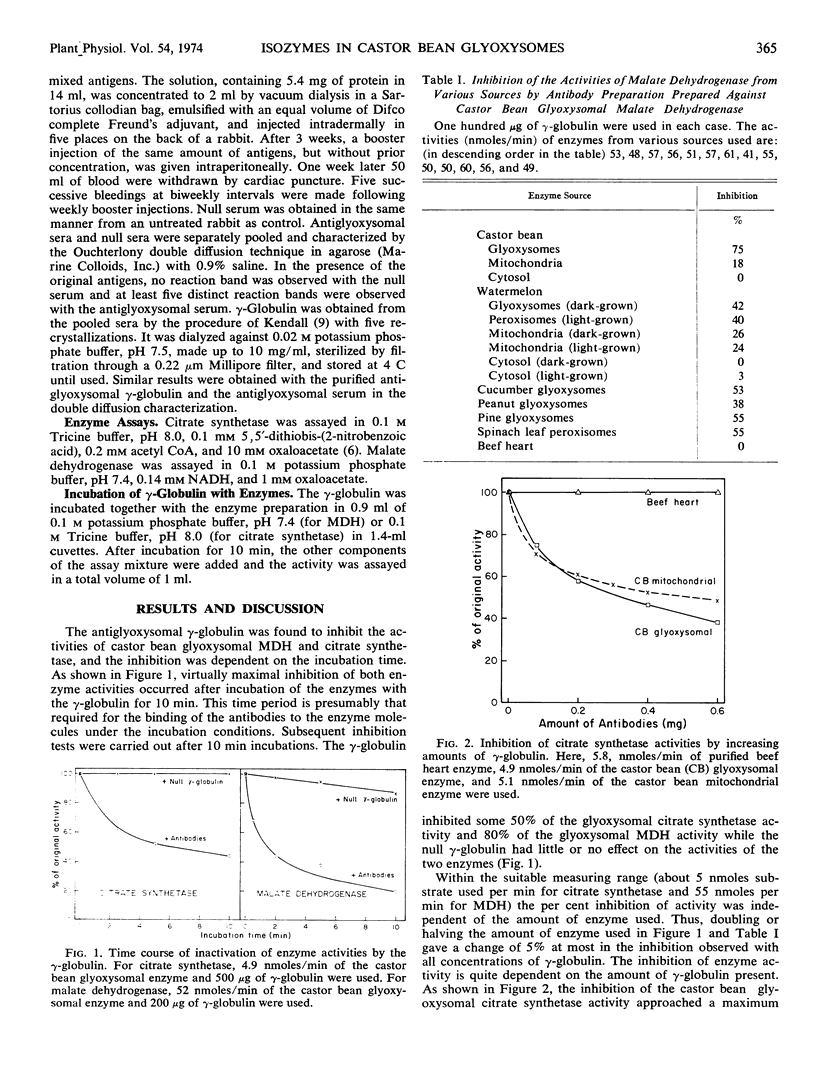Abstract
Rabbit γ-globulin obtained after the injection of solubilized proteins of castor bean (Ricinus communis L var. Hale) glyoxysomes contains antibodies against some of the glyoxysomal enzymes. The γ-globulin was shown to inhibit by 50% and 80%, respectively, the in vitro activities of the castor bean glyoxysomal citrate synthetase and malate dehydrogenase. The conditions required for the inactivation are described.
The glyoxysomal and mitochondrial citrate synthetase from castor bean endosperm show no significant difference in the above immunological test, in their apparent Michaelis constant values for acetyl coenzyme A and oxaloacetate, or in their sensitivity toward ATP inhibition. In the immunological test, glyoxysomal malate dehydrogenase from castor bean endosperm appeared to be related more closely to the leaf peroxisomal malate dehydrogenase from spinach (Spinacia oleracea L.) and to the glyoxysomal malate dehydrogenase from a variety of other fatty seedlings than to the castor bean mitochondrial or soluble malate dehydrogenase. Unlike the mitochondrial or soluble malate dehydrogenase, the castor bean glyoxysomal malate dehydrogenase is easily inactivated by gentle heat treatment, as was reported previously by other workers for the leaf peroxisomal malate dehydrogenase. Thus, the malate dehydrogenases from various plant microbodies share some common characteristics which distinguish them from other isozymes of malate dehydrogenase.
Full text
PDF



Selected References
These references are in PubMed. This may not be the complete list of references from this article.
- Axelrod B., Beevers H. Differential response of mitochondrial and glyoxysomal citrate synthase to ATP. Biochim Biophys Acta. 1972 Feb 28;256(2):175–178. doi: 10.1016/0005-2728(72)90050-3. [DOI] [PubMed] [Google Scholar]
- Beevers H. Glyoxysomes of castor bean endosperm and their relation to gluconeogenesis. Ann N Y Acad Sci. 1969 Dec 19;168(2):313–324. doi: 10.1111/j.1749-6632.1969.tb43118.x. [DOI] [PubMed] [Google Scholar]
- Breidenbach R. W. Characterization of some glyoxysomal proteins. Ann N Y Acad Sci. 1969 Dec 19;168(2):342–347. doi: 10.1111/j.1749-6632.1969.tb43120.x. [DOI] [PubMed] [Google Scholar]
- Huang A. H., Beevers H. Localization of enzymes within microbodies. J Cell Biol. 1973 Aug;58(2):379–389. doi: 10.1083/jcb.58.2.379. [DOI] [PMC free article] [PubMed] [Google Scholar]
- Rocha V., Ting I. P. Malate dehydrogenases of leaf tissue from Spinacia oleracea: properties of three isoenzymes. Arch Biochem Biophys. 1971 Nov;147(1):114–122. doi: 10.1016/0003-9861(71)90316-x. [DOI] [PubMed] [Google Scholar]
- Srere P. A. An eclectic view of metabolic regulation: control of citrate synthase activity. Adv Enzyme Regul. 1970;9:221–233. doi: 10.1016/s0065-2571(71)80046-8. [DOI] [PubMed] [Google Scholar]
- Trelease R. N., Becker W. M., Gruber P. J., Newcomb E. H. Microbodies (Glyoxysomes and Peroxisomes) in Cucumber Cotyledons: Correlative Biochemical and Ultrastructural Study in Light- and Dark-grown Seedlings. Plant Physiol. 1971 Oct;48(4):461–475. doi: 10.1104/pp.48.4.461. [DOI] [PMC free article] [PubMed] [Google Scholar]
- Yamazaki R. K., Tolbert N. E. Malate dehydrogenase in leaf peroxisomes. Biochim Biophys Acta. 1969 Mar 18;178(1):11–20. doi: 10.1016/0005-2744(69)90127-2. [DOI] [PubMed] [Google Scholar]


